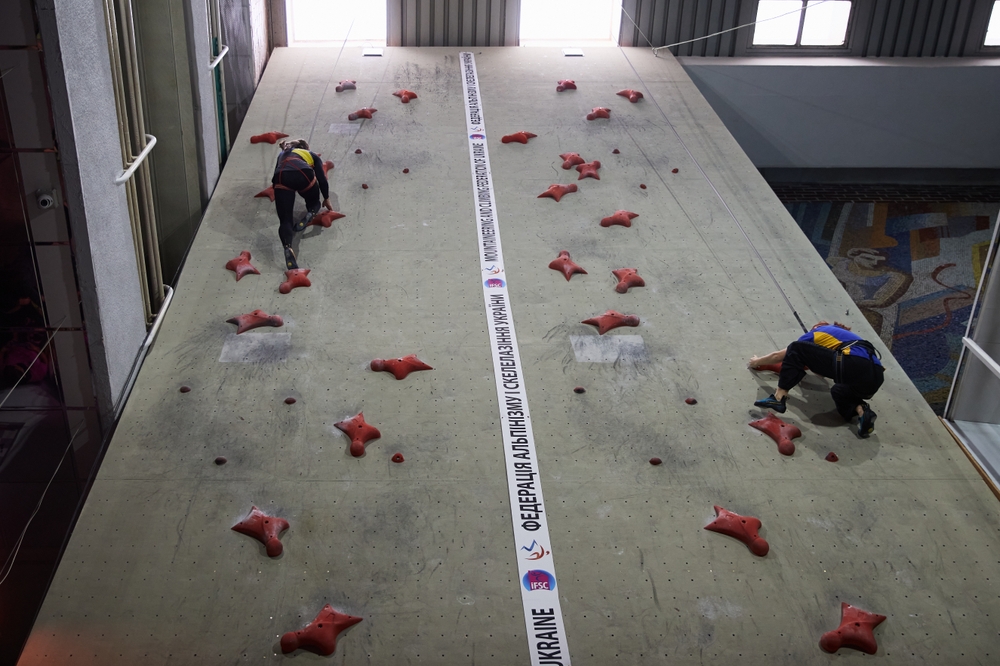Biomechanics of Competitive Bouldering
The world of competitive bouldering has exploded in popularity, captivating audiences with its blend of raw strength, strategic problem-solving, and artistic movement. As climbers scale seemingly impossible routes without ropes, a complex interplay of biomechanical forces unfolds. This article delves into the intricate science behind the sport, exploring how elite boulderers push the boundaries of human physical capability.

The Foundations of Bouldering Biomechanics
At its core, bouldering is a constant negotiation between the climber’s body and the forces acting upon it. Gravity, the ever-present antagonist, pulls relentlessly downward, while friction between skin and hold provides the crucial counterforce. The successful boulderer must manipulate these forces through precise body positioning and movement.
The concept of center of gravity plays a pivotal role in bouldering biomechanics. Climbers strive to maintain their center of gravity as close to the wall as possible, reducing the moment arm and thereby decreasing the force required to hold position. This often manifests in the characteristic “frog-like” stance seen in many bouldering moves, with hips thrust close to the wall and limbs splayed outward.
Proprioception, the body’s ability to sense its position in space, is another critical factor. Elite boulderers develop an acute awareness of their body’s orientation, allowing for minute adjustments in positioning that can mean the difference between sticking a hold and falling. This heightened sense of body awareness is honed through countless hours of practice and is often described by climbers as a form of “body intelligence.”
The Power of the Pull
While the entire body is engaged in bouldering, the upper body, particularly the arms and shoulders, bear the brunt of the work. The biomechanics of pulling in bouldering are complex, involving multiple muscle groups working in concert.
The latissimus dorsi, or “lats,” are the powerhouse muscles of climbing, responsible for the majority of pulling force. These broad, flat muscles spanning the middle and lower back contract to bring the arms downward and inward. Working in tandem with the lats are the biceps brachii, which flex the elbow joint, and the brachialis, which lies deeper in the upper arm and is crucial for sustained elbow flexion.
However, raw pulling strength alone is insufficient for high-level bouldering. The ability to generate and control rotational force, or torque, is equally important. This is where the often-overlooked muscles of the rotator cuff come into play. These small but crucial muscles stabilize the shoulder joint and allow for the precise movements required in technical climbing sequences.
Lower Body Dynamics
While the upper body may steal the spotlight, the lower body is the unsung hero of bouldering biomechanics. The legs, with their larger muscle groups, are capable of generating far more force than the arms and play a critical role in propelling the climber upward.
The quadriceps and gluteal muscles are the primary movers in many climbing movements, particularly in explosive jumps or “dynos.” These powerful muscles work to extend the hip and knee joints, driving the climber upward. The calf muscles, specifically the gastrocnemius and soleus, are crucial for maintaining tension on small footholds and generating upward force through the toes.
Perhaps even more important than raw leg strength is hip mobility and control. The ability to place the feet with precision and generate force in a variety of angles is a hallmark of advanced climbing technique. This requires not only flexibility in the hip joint but also strength and coordination in the smaller stabilizing muscles surrounding the hip.
The Core: The Climber’s Powerhouse
At the nexus of upper and lower body biomechanics lies the core, the true powerhouse of bouldering movement. A strong, stable core allows for efficient transfer of force between the limbs and helps maintain body tension crucial for many climbing moves.
The rectus abdominis, the “six-pack” muscle, plays a role in flexing the trunk, but it’s the deeper core muscles that are truly essential for climbing. The transversus abdominis, for example, acts like a natural weight belt, compressing the abdominal contents and stabilizing the spine. The multifidus, a series of small muscles running along the spine, provides crucial rotational stability.
One of the most important functions of the core in bouldering is maintaining body tension. This is particularly evident in overhung or horizontal climbing, where the body must resist the tendency to sag away from the wall. This tension is achieved through co-contraction of the abdominal and back muscles, creating a rigid “cylinder” that allows for efficient transfer of force from the hands to the feet.
Finger Strength: The Limiting Factor
While large muscle groups generate the majority of force in bouldering, it’s often the small muscles of the fingers that determine a climber’s ultimate limit. The biomechanics of finger strength in climbing are both fascinating and complex.
The fingers are controlled by two sets of muscles: extrinsic muscles, which originate in the forearm, and intrinsic muscles, located within the hand itself. The extrinsic muscles, including the flexor digitorum superficialis and flexor digitorum profundus, are responsible for the bulk of gripping strength. The intrinsic muscles, such as the lumbricals and interossei, provide fine motor control and stability.
One of the most crucial aspects of finger strength in bouldering is the ability to generate force in a variety of grip positions. Open-hand grips, where the fingers are relatively straight, rely heavily on friction and are less strenuous on the tendons. Crimping, where the fingers are sharply bent and the thumb often wraps over the index finger, allows for maximum force generation but places extreme stress on the finger joints and tendons.
The development of finger strength is a slow process, limited by the relatively poor blood supply to the tendons and ligaments of the fingers. This makes finger injuries a common and often career-limiting factor for climbers, underscoring the importance of proper training and recovery protocols.
Energy Systems and Metabolic Demands
While individual bouldering problems may only last a matter of seconds, the metabolic demands of the sport are intense and multifaceted. Understanding the energy systems at play is crucial for optimal training and performance.
The phosphagen system, which relies on stored ATP and creatine phosphate, is the primary energy source for the explosive, high-intensity efforts typical of bouldering. This system can provide enormous power output but is depleted within 10-15 seconds of maximal effort. The ability to rapidly replenish phosphagen stores between attempts is a key factor in bouldering performance.
As a boulder problem extends beyond the capacity of the phosphagen system, the body begins to rely more heavily on anaerobic glycolysis. This system, which breaks down glucose in the absence of oxygen, can sustain high-intensity effort for up to about two minutes but results in the accumulation of lactic acid, leading to the characteristic “pump” felt in the forearms.
For longer boulder problems or extended climbing sessions, the aerobic system becomes increasingly important. While not capable of supporting the peak intensities required for difficult moves, a well-developed aerobic system allows for faster recovery between attempts and can help delay the onset of fatigue.
Neuromuscular Coordination and Motor Learning
Beyond raw strength and endurance, successful bouldering requires a high degree of neuromuscular coordination and refined motor skills. The ability to execute precise movements, often under conditions of extreme physical stress, is a hallmark of elite climbing performance.
Motor learning in bouldering occurs through a process of trial and error, with climbers gradually refining their movement patterns through repeated attempts. This leads to the development of motor engrams, or stored movement patterns, which can be quickly accessed and executed in similar climbing situations.
One fascinating aspect of motor learning in bouldering is the concept of “beta,” the sequence of movements used to complete a problem. Experienced climbers can often visualize and mentally rehearse beta before attempting a problem, a process known as motor imagery. Research has shown that this mental practice can lead to improved performance and faster learning of new movement patterns.
The role of proprioception in motor learning cannot be overstated. As climbers develop a more acute sense of their body position and movement, they become capable of making minute adjustments mid-move, a skill often referred to as “micro-beta.” This ability to adapt and refine movements in real-time is a key differentiator between intermediate and elite-level climbers.
Biomechanical Adaptations in Elite Boulderers
Long-term engagement in high-level bouldering leads to a number of specific biomechanical adaptations. These changes, both structural and functional, allow elite climbers to perform at levels that seem to defy conventional understanding of human physical limits.
One of the most notable adaptations is increased bone density, particularly in the fingers and forearms. Studies have shown that experienced climbers have significantly higher bone mineral density in these areas compared to non-climbers, a adaptation that helps prevent fractures under the extreme loads encountered in difficult climbing moves.
Tendon hypertrophy is another common adaptation, with climbers showing increased cross-sectional area of key tendons, particularly in the fingers. This adaptation allows for greater force transmission and may help prevent injuries, although the slow nature of tendon remodeling underscores the importance of gradual progression in training intensity.
Grip strength in elite boulderers often far exceeds what would be expected based on muscle cross-sectional area alone. This is partly due to neural adaptations, including increased motor unit recruitment and improved firing synchronization. Additionally, climbers develop the ability to selectively engage specific muscle fibers, allowing for precise modulation of grip force.
Postural adaptations are also common among high-level boulderers. These include increased thoracic kyphosis (rounded upper back) and protracted scapulae, which may allow for greater reach and improved force generation in overhanging terrain. While these adaptations can be advantageous for climbing performance, they may also increase the risk of certain overuse injuries if not properly managed.
Injury Prevention and Performance Optimization
Understanding the biomechanics of bouldering is crucial not only for performance enhancement but also for injury prevention. The high forces and often unnatural positions encountered in climbing can lead to a variety of acute and chronic injuries if not properly managed.
One of the most common injuries in bouldering is pulley strain or rupture in the fingers. These small ligaments, which hold the finger tendons close to the bone, can be damaged by the extreme forces encountered in certain grip positions, particularly the closed crimp. Prevention strategies include gradual loading progression, avoiding excessive crimping during training, and incorporating exercises to strengthen the antagonist muscles.
Shoulder injuries are another significant concern, with impingement syndrome and rotator cuff tears being particularly common. These can often be prevented through proper warm-up routines, technique refinement to avoid excessive shoulder internal rotation, and targeted strengthening of the rotator cuff and scapular stabilizing muscles.
From a performance optimization perspective, biomechanical analysis can provide valuable insights for technique refinement. High-speed video analysis, for example, can reveal inefficiencies in movement patterns or opportunities for improved body positioning. Force plate analysis can help climbers understand how they’re distributing weight between hands and feet, potentially leading to more efficient and less physically taxing climbing styles.
The Future of Bouldering Biomechanics
As the sport of bouldering continues to evolve, so too does our understanding of its biomechanics. Emerging technologies are opening up new avenues for research and performance analysis.
Wearable sensors, capable of measuring forces, accelerations, and joint angles in real-time, are providing unprecedented insights into the dynamics of climbing movement. This data, when combined with machine learning algorithms, could potentially lead to highly personalized training recommendations and injury prevention strategies.
Virtual and augmented reality technologies are also showing promise in the field of motor learning for climbing. These tools allow for the creation of simulated climbing environments where movements can be practiced and refined without the physical risks associated with actual climbing.
Genetic research is another frontier in climbing biomechanics. Studies are beginning to identify genetic markers associated with elite climbing performance, including genes related to finger strength, power-to-weight ratio, and mental traits such as fear response. While the ethical implications of such research are still being debated, it could potentially revolutionize talent identification and development in the sport.
As bouldering continues to gain popularity and push the boundaries of human physical capability, the field of biomechanics will play an increasingly crucial role. By deepening our understanding of the complex interplay of forces, movements, and physiological adaptations involved in climbing, we can not only enhance performance but also make the sport safer and more accessible to a wider range of participants.
The biomechanics of competitive bouldering represent a fascinating intersection of physics, physiology, and psychology. As climbers continue to push the limits of what’s possible on vertical terrain, the insights gained from biomechanical research will undoubtedly play a crucial role in shaping the future of this dynamic and evolving sport.





